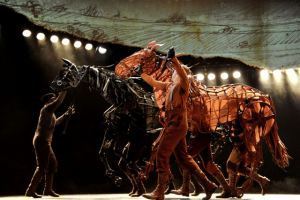Narrelle M. Harris's Blog, page 39
January 20, 2013
Review: The Barrumbi Kids by Leonie Norrington (AWW Challenge 2013 #1)
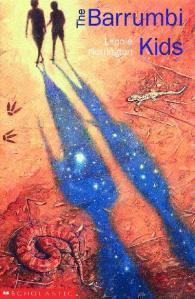 I picked up The Burrumbi Kids ages ago (at the superb Embiggen Books in Melbourne) but didn’t get to it in time for last year’s Australian Women Writers Challenge. Naturally, I took it with me on my wee New Year break in the Dandenongs and promptly read it in a day!
I picked up The Burrumbi Kids ages ago (at the superb Embiggen Books in Melbourne) but didn’t get to it in time for last year’s Australian Women Writers Challenge. Naturally, I took it with me on my wee New Year break in the Dandenongs and promptly read it in a day!
The Barrumbi Kids is the story of best friends, Dale and Tomias, who live in the little outback town of Barrumbi in the Northern Territory. Their days are filled with negotiating school, teachers, family, enemies and the two cultures from which they come. They both love the land, even though it can be a dangerous place: fire, snakes, crocodiles and drought all present moments of excitement and challenge.
Norrington, who lived in an outback community herself, paints a vivid picture of the land and the bush community. There are lively, believable relationships and interactions between not only indigenous and white cultures but the clashing cultures of a rural community and big-city folks who struggle to fit in (and cope with all the red dust).
Dale and Tomias are fabulous characters with a strong, believable friendship. They make mistakes and fight sometimes, but they come across as very real, and with a very real connection. They start off by wagging school which leads to the boys being caught in a grass fire and an immediate cross-cultural dilemma, because Dale has compromised his friend. He does what good friends do, though, to make up for his mistake.
Another terrific character is Lizzie, Dale’s smart and resourceful little sister, who gets her own rivetting scene when confronted with a crocodile and has to stare it down, as Auntie Mavis, a local elder, has taught her to.
Norrington does an excellent job of creating and exploring cross-cultural issues with both white/indigenous, bush/city divides. The dilemmas she poses are plausible and nuanced, without being heavy handed, stereotypical or predictable in her approach. The language she uses flows beautifully, but is also vivid and distinctive. Indigenous words are part of her linguistic palette, as they should be in this setting.
The excellence of The Barrumbi Kids was recgonised with shortlistings for the 2003 NSW Premier’s Literary Award Patricia Wrightson Prize and Children’s Book Council of Australia Awards, and more books in the same setting have followed. They’re now on my wish list!
Get The Barrumbi Kids from Boomerang Books
Narrelle M Harris is a Melbourne-based writer. Find out more about her books, smartphone apps, public speaking and other activities at www.narrellemharris.com.


January 16, 2013
Invasion at Warrnambool!
 Museums and pop culture – especially SFnal pop culture – never used to occupy the same space. They still don’t, on the whole, but in Warrnambool, a country town in western Victoria, that juxtaposition is on offer until 28 January.
Museums and pop culture – especially SFnal pop culture – never used to occupy the same space. They still don’t, on the whole, but in Warrnambool, a country town in western Victoria, that juxtaposition is on offer until 28 January.
The Warrnambool Art Gallery’s Invasion exhibition is housing the touring British exhibition of SF costumes, props, promotional figures and replicas for the duration.It’s an eclectic mix of material from TV shows and films, including Red Dwarf, various Star Trek series, the Alien and Predator films, Dr Who, Metropolis, theDune series, Lost in Space, The Chronicles of Riddick and The Black Hole.
It’s always fascinating to see the make-believe up close, to see what it looks like before celluloid, clever lighting and post-production turn cloth and rubber into facsimiles of a more real-looking world. There’s artistry not only in the original design, then, but in imagining how these things will transform through another medium (film and the screen) to look different again. That’s two layers of creative vision right there.
Museum staff said that some locals found it all a bit odd – what’s a costume from a TV show doing in an art gallery? But staff also said that the exhibition attracted all manner of visitors: not just the expected SF geeks, but people interested in design, fashion, craftwork and models.
Is it because this form of art and design is commercial that it gets so little respect from the average punter? Is it because this form of art and design is used to entertain instead of being ‘serious art’?
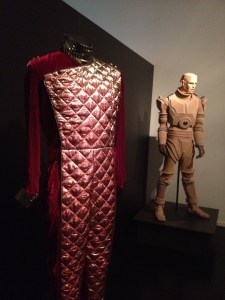 To me, these costumes and models being made for entertainment doesn’t make the skill and imagination behind them less admirable. The gorgeous and enduring art deco design of the robot from Metropolis is an amazing piece of work, no matter its origins. The reflective, padded suit from Red Dwarf’s holoship is both ridiculously shiny and completly evocative of that too-shiny, too-perfect concept of a ship. The Dalek pepperpot is simple and almost mundane but also evocative of fascist uniforms (and uniformity) and has been an enduring symbol of evil for TV viewers since the 60s. That’s not just script – that’s excellent design work.
To me, these costumes and models being made for entertainment doesn’t make the skill and imagination behind them less admirable. The gorgeous and enduring art deco design of the robot from Metropolis is an amazing piece of work, no matter its origins. The reflective, padded suit from Red Dwarf’s holoship is both ridiculously shiny and completly evocative of that too-shiny, too-perfect concept of a ship. The Dalek pepperpot is simple and almost mundane but also evocative of fascist uniforms (and uniformity) and has been an enduring symbol of evil for TV viewers since the 60s. That’s not just script – that’s excellent design work.
One particularly cool thing about the Warrnambool exhibition is that visitors can get up close to the displays and see the fine detail on how these things were made: the warp and weft of the material; the paintwork on the models; the shortness of some of the molded outfits that indicate Patrick Stewart and Matt leBlanc are both much more petite than I would have thought!
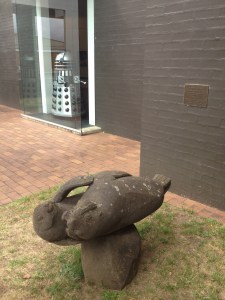 Warrnambool has other pleasures on offer, by the way, including a lovely bay beach, an old cinema and some very nice cafes, so if you have some time and an inclination to indulge either your geek interests or passion for craft, art and design, it’s a lovely time of year to visit the coast.
Warrnambool has other pleasures on offer, by the way, including a lovely bay beach, an old cinema and some very nice cafes, so if you have some time and an inclination to indulge either your geek interests or passion for craft, art and design, it’s a lovely time of year to visit the coast.
Full disclosure: I travelled to Warrnambool courtesy of V-Line and visited the gallery as a guest of the Warrnambool Art Gallery.
Narrelle M Harris is a Melbourne-based writer. Find out more about her books, smartphone apps, public speaking and other activities at www.narrellemharris.com.


January 12, 2013
Review: War Horse at the Arts Centre, Melbourne
 I have a confession to make. When I was a tween, before I discovered fantasy and SF, I had a passion for horse stories. I loved animal stories in general, but the horse stories had me every single time.
I have a confession to make. When I was a tween, before I discovered fantasy and SF, I had a passion for horse stories. I loved animal stories in general, but the horse stories had me every single time.
My Friend Flicka, The Palamino Horse, Black Beauty, National Velvet, pretty much everything by Margeurite Henry, not to mention the Australian series, The Silver Brumby by Elyne Mitchell and Mary Elwyn Patchett’s numerous series including The Brumby and Tam the Untamed. Some of my first fantasy books were reading about unicorns and winged horses, and of course The Horse and His Boy from the Narnia series.
Yep, I had it bad. If only my parents had given me an actual pony. It could totally have lived in my room with me.
Now I think about it, moving from horse stories to dragon stories, a la Pern, was a natural progression, and from there I moved on to all kinds of SF, fantasy, crime and horror. Nevertheless, I retain a soft spot for well told animal stories.
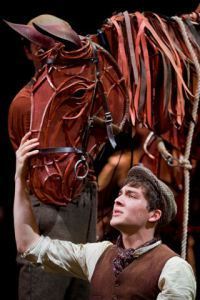 Enter, stage left, War Horse. I saw the film (I must confess partly because the recent Sherlock Holmes, Benedict Cumberbatch, was in it and I wanted to see him in something else) and liked it well enough.
Enter, stage left, War Horse. I saw the film (I must confess partly because the recent Sherlock Holmes, Benedict Cumberbatch, was in it and I wanted to see him in something else) and liked it well enough.
The prospect of a stage version, though, had me intrigued and excited. The puppetry and stagecraft of the stage version of The Lion King had impressed me and I wanted to see how those techniques would apply to concepts as large as life-sized horses and a whole world war on the stage.
I didn’t realise that War Horse originated as a book until after the show, but as I sat there watching the story unfold, I thought that it must have been from that genre. I recognised the traditional patterns of all of those books I’d read in my childhood. Particularly resonant was the typical tale of a young person (a boy, as is so often the case in these books, Albert in this case) and his intense, pure love for his horse (Joey). This pattern seemed at odds, though, with the much more violent, adult aspects of the story, with the horrors of war very clearly shown, including the deliberate shootings of both humans and animals.
It’s a juxtaposition that is a little jarring, and I think my 10-year-old self would have been deeply distressed by this production. Still, at 13 I might have loved it, though probably I’d have cried. Hell, I’m a full grown adult now and I still got very emotional, particularly at the fates of the animals.
The puppetry in War Horse is absolutely brilliant. The horse constructs are complex and move with surprising naturalism, from the distinctive gait of a colt to the heaving of a chest, post-gallop, and the flicking of an equine tail.
Each horse has three operators, and they don’t just move the limbs, head, tail and torso. They make sounds and are hugely physically expressive. They are literally and figuratively the animating spirit of the horses. When one of the animals dies and the puppeteers slowly withdraw, stand at attention and then, as one, leave the stage, I had tears in my eyes. I was watching the spirit leave that horse, and it was sad.
Anthropomorphism provokes a strong emotional response in me, and I found myself much more involved in the horses – and even the hilarious goose at the farm who likes to, well, goose everyone – than the human cast. In the first act I sometimes felt the puppet animals were more emotionally complex and realistic than some of the people.
The second half addresses this lack, with Albert suffering through so much in his search for Joey on the battlefields of France and losing his faith. He finally gains the emotional texture to lift the character out of the simple, broad strokes of archetype to a person as real as Joey the horse has become.
Oddly, having seen the film took some of the excitement out of the play for a while, as I thought I knew what was coming next. However, the stage show plot differs in some respects to the film, which was a boon when I suddenly realised in one section that I didn’t know what happened to these people. The suspense returned. I knew how the big picture would end, but not the lives of the other characters.
On the whole, War Horse is an excellent production. I haven’t spent any time here talking about the wonderful exeuction of the lighting, backdrop design, the battle sequences, the vocal soundscapes with the beautiful singing, the general sound design, and the costuming. It’s a handsome production, beautifully performed, even though the humans are less complex than they could be. The puppets of course are extraordinary, with their wonderful puppeteers, transcending their shapes of wood and wire, and that’s a bit of theatre magic totally worth the price of entry.
War Horse is on at the Arts Centre, Melbourne until 10 March 2013, tickets from $79.90 for B Reserve. See more at the Arts Centre site.
Narrelle M Harris is a Melbourne-based writer. Find out more about her books, smartphone apps, public speaking and other activities at www.narrellemharris.com.


January 6, 2013
Review: The Rook by Daniel O’Malley
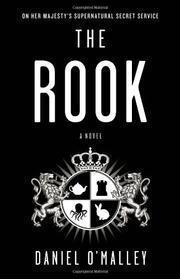 I pick up books for a lot of different reasons: a review makes it sound appealing; word of mouth; the title or the cover has caught my eye; I already like the author. Sometimes the thing that sets me reaching for the shelf (or the buy button) is actually meeting the writer.
I pick up books for a lot of different reasons: a review makes it sound appealing; word of mouth; the title or the cover has caught my eye; I already like the author. Sometimes the thing that sets me reaching for the shelf (or the buy button) is actually meeting the writer.
I met Daniel O’Malley at Genrecon in 2012 and was instantly engaged by his wit, sardonic humour and, very possibly, his mop of endearing curly hair. It was an obvious conclusion that a man that funny and smart had probably written a funny and smart book, and as soon as I got home I bought his debut novel, The Rook, and began to read.
The Rook is indeed as smart and funny as its creator. A young woman wakes up in a London park with no memory, surrounded by dead people wearing latex gloves and a bearing a remarkable letter in her coat pocket. It reads:
The body you are wearing used to be mine.
Thus begins Myfanwy Thomas’s frightening, dangerous and often very funny adventure into paranormal powers, even-more-secret-than-usual secret agents, just-as-secret histories and murky threats of world domination.
Myfanwy soon learns that she is a woman of strange powers, although her former self was more proficient at being a superb beaurocrat than any kind of superhero, and that she’s part of a secret British organization full of people more adept with their superpowers than she is. It’s treacherous ground to be walking when you know who you are and what you can do: when you’re a woman coping with amnesia, it’s the devil’s own business to know who to trust, let alone work out which of your super-powered colleagues is trying to kill you and why.
The Rook has sets an energetic pace, but doesn’t neglect character development as it tears along. Myfanwy may be rebuilding who she is nearly from scratch, but she has another past, and the emotional texture of her history is important to the Myfanwy she is becoming. It’s also relevant to the motivations behind the events that have led her to bluffing her way through daily paperwork as well as monstrous incursions in the field.
The humour and horror are just as well balanced as the action and reflection, and the central mystery is finally unveiled and addressed in a very satisfying manner.
I’m delighted that The Rook lived up to the promise inspired by its author, and I’m very much looking forward to the next in the series, which O’Malley assured us he was writing at the time of Genrecon.
Buy The Rook: A Novel
 from Amazon.com
from Amazon.comRead the first four chapters, see the book trailer and find out more at The Rook Files.
Narrelle M Harris is a Melbourne-based writer. Find out more about her books, smartphone apps, public speaking and other activities at www.narrellemharris.com.


January 1, 2013
Everything old is new again
My father recently gave me a charming anthology called The Family Book of Best Loved Short Stories, a Doubleday edition from 1954, edited by Leland W Lawrence. He said he’d seized upon it long ago because it had Rudyard Kipling’s The Man Who Would Be King in its contents.
I took it with me on my recent reading holiday because it contained a lot of stories I’d heard of but never read, including the Kipling piece.
While some of the stories in the book didn’t work so well for me – I’m still not sure of the point of Mark Twain’s The Celebrated Jumping Frog of Calaveras County – it was delightful to be reminded, once more, of the joys of reading stories from earlier eras: especially if they are stories that you think you know well.
It’s tempting to steer clear of 19th century writing, for example, as the writing style is so much more complex and circumlocutery than contemporary fiction. Perhaps there’s a tendency to think of writing from the era as stodgy and earnest and lacking in humour. But you’d be wrong.
There’s a rakish delight in Thomas Bailey Aldrich’s epistolery Marjorie Daw as two friends exchange letters, and I had to read sections aloud to my other half because they were too funny not to share. I was surprised by the ending (and found a definitely more modern homoerotic subtext that may not have originally been intended). Bret Harte’s The Outcasts of Poker Flat had its devilish moments too, and reminded me of Eric Frank Russell’s later story, Somewhere A Voice.
The greatest treat of the collection, however, was Charles Dickens’ A Christmas Carol. It’s a story we know well – or think we do – due to countless rehashings in Christmas films, holiday specials and the like. The Blackadder Christmas Special is one of my favourite send-ups of the tale!
But on receiving this book, I realised I’d never read the original. And what a revelation it was!
The story has a flow and elegance, and a distinct rhythm to the language. While the language can be archaic, there’s real music in it, not to mention wit, and some truly splendid imagery. The description of roasted chestnuts piled in ‘apoplectic opulence’ captures beautifully the picture of glossy brown nuts bursting open. The reference to a household full of exuberant children – ‘they were not forty children conducting themselves like one, but every child was conducting itself like forty’ – reminded me happily of my childhood, where my four brothers and I conducted ourselves in this manner most holidays.
There’s even the quite adorable description of Scrooge’s small house tucked into the back streets as though ‘it must have run there when it was a young house, playing at hide-and-seek with other houses, and forgotten the way out again’. Not only is it a wonderfully playful, whimsical description, it gives the reader some hope that, miserable as Scrooge is, maybe there was something innocent about him once and, like the house, perhaps he just got lost and forgot the way out again.
It turns out that returning to the source of a well-worn story can lead you to rediscovering gems, and learning why these writers are considered to be Great Writers in the first place. Dickens has more eloquence and humour than I’d realised; O Henry’s Gift of the Magi isn’t anything like as maudlin and sappy as the story is annually portrayed.
I resist making New Year’s Resolutions, but I think this year I’ll make an attempt to read more of the classics and redisc0ver for myself what all the fuss is about.
Narrelle M Harris is a Melbourne-based writer. Find out more about her books, smartphone apps, public speaking and other activities at www.narrellemharris.com.


December 20, 2012
A few wishes for the new year

How To: Make A Paperback Christmas Tree by Kayla Aimee
If you are one of those people for whom books repurposed as art gives you hives, look away now.
For the rest of us, here are some instructions onhow to turn a damaged or unwanted paperback into a little Xmas tree.
Which brings me to the season: and whether it is hot or cold where you reside, whether you celebrate Xmas as a Christian, on your own terms or not at all, I hope the end of 2012 is going smoothly for you, and that 2013 promises good things to you and yours.
If your year was rough, may there be smoother times ahead.
If your year was full of brilliance, may you count your blessings.
May you find ways to express your creativity, whatever they are, and even if you think you’re no good at it. Nobody ever got better at their passion by refusing to practise because it wasn’t perfect the first time.
May you be kind to those who need kindness, even if they don’t necessarily deserve it, and may the world in turn be kind to you. Certainly, may you be kind to yourself. We so often are harsher on ourselves than others would be, and that’s not healthy or productive.
May you learn more about yourself so that you can understand what will bring you contentment, fulfillment and satisfation, and then find ways to do those things instead of the things that make you frustrated and sad.
May the coming year bring you growth, surprises, enough challenge to be good for you and enough rest to keep you well.
See you in 2013!


December 4, 2012
The Next Big Thing
 You may have seen the blog chain winding its links around the Australian writing community lately. Tansy Rayner Roberts tagged me (read her contribution here) and here is my effort at answering the standard questions. I actually have two concurrent projects (actually, three, but the third involves short stories, so I thought I’d leave them out of it) so it got a bit complicated. Apparently, complicated and way too busy is my thing. Free time is anathema to me.
You may have seen the blog chain winding its links around the Australian writing community lately. Tansy Rayner Roberts tagged me (read her contribution here) and here is my effort at answering the standard questions. I actually have two concurrent projects (actually, three, but the third involves short stories, so I thought I’d leave them out of it) so it got a bit complicated. Apparently, complicated and way too busy is my thing. Free time is anathema to me.
What is the working title of your next book?
I have a couple of projects going simultaneously at the moment, which is madness, I know. Believe me. They’re not even the only two projects I’m developing.
One project is the third Gary/Lissa vampire novel, with the working title of Beyond Redemption. The new project is being developed under the title Kitty and Cadaver.
Where did the idea come from for the book?
Kitty and Cadaver came about basically because I love books in which rock and roll saves the world from monsters. There aren’t nearly enough of them, so I decided to write one.
Beyond Redemption is the third in a trilogy and will finish the Gary and Lissa’s story.
What genre does your book fall under?
Both of them are urban fantasy books. Well, I suppose Kitty and Cadaver is urban fantasy come rock opera.
What actors would you choose to play the part of your characters in a movie rendition?

Toby Truslove
For Gary and Lissa, I’ve been thinking lately that Toby Truslove (Outland, Laid, The Strange Calls) would make a good Gary, if he chubbed up a bit. For Lissa, an actress named Maya Stange (Garage Days) has a great look. (Actually, I think they’re both older than the characters, but they fit with my ideas of the characters.) Magda Szubanski was always the model for the vampire queen Magdalene, of course.
I haven’t got that far with the characters for Kitty and Cadaver yet.
What is the one-sentence synopsis of your book?
I will cheat by writing very long sentences.
Beyond Redemption: Gary is at the end of his tether, then he gets an idea that is either completely brilliant or completely stupid, particularly in light of the latest ructions in the vampire community and the return of Lissa’s mother.
Kitty and Cadaver: The surviving members of the rock band with a mission to save the world from monsters stumble across the zombie apocalypse in Melbourne, but need to find a new lead singer with a magic voice before they can confront the undead as well as their own demons.
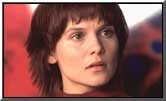
Maya Stange
Will your book be self-published or represented by an agency?
Beyond Redemption will come out with Clan Destine Press. I don’t know what will happen yet with Kitty and Cadaver. I’ll be approaching an agent when I have a completed manuscript ready to go, but Clan Destine has expressed interest in that as well.
How long did it take you to write the first draft of the manuscript?
I’m still working on them both, but first drafts usually take me 12 to 18 months, since I write them outside my day job hours. I’m hoping to go down to three days a week in day job hours in 2013, so maybe I’ll get these ones done more quickly for a change.
What other books would you compare this story to within your genre?
Obviously Beyond Redemption is on a line with the other vampire novels, The Opposite of Life and Walking Shadows. Comic, non-romance urban vampire books in general, I suppose.
Kitty and Cadaver will be a bit like other rock ‘n’ roll saves the world books: Scott Westerfeld’s Peeps and The Last Days, and Emma Bull’s The War for the Oaks come to mind. (If anyone has recommendations for other books along these lines, I’d love to hear about them!)
Who or what inspired you to write this book?
For Kitty and Cadaver – Rock ‘n’ Rooooooooollllllllll!!
More helpfully: I’d been noodling about writing lyrics (and a bit of music, but it’s been a long time since I played an instrument) to stretch myself and I loved doing it. I last wrote songs for some Blake’s 7 filk about thirty years ago, though I’ve dabbled a bit in the interim. But I loved doing it so much that I wanted to do a story that used music a lot more. Music, magic, monsters: a perfect combination, surely?
What else about the book might pique the reader’s interest?
Music will be an integral part of Kitty and Cadaver, and I’m working with my niece, who is a musician, on developing songs that will be used in the stories. So it’ll be a multimedia bonanza!! Woooot!
Narrelle M Harris is a Melbourne-based writer. Find out more about her books, smartphone apps, public speaking and other activities at www.narrellemharris.com.


November 29, 2012
Review: The Interrogation of Ashala Wolf by Ambelin Kwaymullina (AWW Challenge #11)
 I found out about this book when someone I follow on Twitter was asking for specfic books by Indigenous Australian writers. I retweeted the request, hoping for some tips myself, and the several replies came back about The Interrogation of Ashala Wolf. Despite the teetering pile of books in my library already waiting to be read, I went right out and picked this one up. (Sorry books-still-waiting. Your turn will come, I promise.)
I found out about this book when someone I follow on Twitter was asking for specfic books by Indigenous Australian writers. I retweeted the request, hoping for some tips myself, and the several replies came back about The Interrogation of Ashala Wolf. Despite the teetering pile of books in my library already waiting to be read, I went right out and picked this one up. (Sorry books-still-waiting. Your turn will come, I promise.)
The Interrogation of Ashala Wolf is set 300 years in the future, in a world reshaped by devastating environmental disaster. It’s not only the world that’s changed, though: some human beings have, too. Some have strange and occasionally destructive powers. These people, referred to as Illegals, are seen as a threat to The Balance, and The Balance is everything. It’s the vision and philosophy of the world, and how the survivors hope to keep harmony with the planet and avoid another round with the apocalypse.
But the Illegals don’t think they are a threat to The Balance. Maybe, despite their powers, they are part of it too. At least, The Tribe, runaways with powers who live in the protection of the Firstwood, don’t think they are destined to destroy The Balance.
The story opens on Day One of Ashala Wolf’s incarceration at Detention Centre #3. Ashala, an Illegal, has recovered sufficiently from injuries sustained during her capture to be subjected to interrogation by Chief Administrator Neville Rose. The Chief Administrator aims to find out all about Ashala, her powers and the group of children she lives in hiding with in the Firstwood. Everyone is in danger, from Ashala to the people who trust her to keep them safe. And right there in the interrogation chamber is the person who betrayed her: Justin Connor.
I read this in just a couple of sittings. (I do enjoy me a post-apocalyptic adventure with superpowers!) I certainly had a sense in the first few days of Ashala’s interrogation that something wasn’t quite right, so the ante was upped when the whole story began to unfold. Amberlin Kwaymullina’s style is light and energetic, so the story zips along at a good pace.
Ashara is a terrific character: fierce and nurturing, loving but angry. Georgie, Ember, Jaz and other kids from the Firstwood are all vivid, though Connor struck me as a little bland. Some of the other denizens of this world, like the saurs and the Serpent, were an imaginative addition.
Some of the world-building seems a little thin at times, especially when it comes to the origins of the saurs, but this is only the first of an expected series. I’m looking forward to learning more about the world as it survives now, the concept of The Balance and whether the Serpent will make another appearance.
Otherwise, the themes of living in harmony with the world, treating people with honesty, fairness and respect and the destructive power of hatred and fear are the strong underpinnnings of a fast-paced, exciting adventure. Bring on the second book, Ms Kwaymullin!
Read about The Tribe at The Firstwood.
Buy The Interrogation of Ashala Wolf at Booktopia.
Narrelle M Harris is a Melbourne-based writer. Find out more about her books, smartphone apps, public speaking and other activities at www.narrellemharris.com.


November 25, 2012
Words are Shapely
While watching a show about design a few months ago, I learned that the use of mixed upper and lower cases  on road signs was a deliberate choice. Research showed that people could read the signs from a distance more easily because people could recognise the shape of the word before they could really even read the word.
on road signs was a deliberate choice. Research showed that people could read the signs from a distance more easily because people could recognise the shape of the word before they could really even read the word.
(For the font nerds, the signs and Transport Medium font were designed by Jock Kinneir and Margaret Calvert. You can download the font here or here )
Certainly, I find sentence case easier to read than ALLCAPS, though the word, sentence or whole paragraph in that format has its place.
The realisation reminded me that there is more to appreciating the English language than simply vocabulary, punctuation and grammar. Sometimes there’s a real pleasure in just the look of a whole word, as though it has artistic resonance and visual meaning beyond the collection of letters and the meaning of the word.
I love how the word awkward looks… well, awkward. I love how the word ‘Melbourne’ jumps out at me from a map even when I’m not wearing my glasses. That word has the shape of home in it. I love how the word ‘parallel’ has its own mnemonic in it, the double ‘l’ which is also a set of parallel lines.
Some languages have alphabets that naturally give of themselves to artistic forms. Arabic’s beautiful flowing script is often used artistically. I have an applique street scene I bought in Cairo in the 1990s, in which the buildings spell out ‘in the name of the compassionate and the merciful’ and the moon is a beautiful crescent-shaped Allah.
I only ever learned a little Arabic during my time in Egypt, though I learned to speak and hear more than I could read or write. Still, I can recognise the words for Allah and halal on sight still. Their distsinctive shapes are reminders of a fascinating period of my life, and a fascinting culture.
Recognising words by their shape and appreciating the art of the shape of language are all lines on the spectrum. It’s all part of loving the written word.
(And then there are the glories of the spoken word and onomatopoeia, but that’s the subject for another post.)
Narrelle M Harris is a Melbourne-based writer. Find out more about her books, smartphone apps, public speaking and other activities at www.narrellemharris.com.


November 18, 2012
Lost and Found 1: Bootless
 Walking around any town, any village, any city, I’m always aware of the idea of the unknown history of a place. Who has walked this way before me? What worker, thousands of years ago, paused at the foot of this same pyramid? What Roman soldier took a breath as he stood by this wall back when this was Londinium?
Walking around any town, any village, any city, I’m always aware of the idea of the unknown history of a place. Who has walked this way before me? What worker, thousands of years ago, paused at the foot of this same pyramid? What Roman soldier took a breath as he stood by this wall back when this was Londinium?
Hidden histories aren’t just separated from me by time. People walk past every day, and I sometimes find myself wondering who they are and what their story is. That woman who is smiling as she talks to someone one the phone; that teenage boy who looks so sad: what dramas or everyday histories are unfolding for them? As a writer, and therefore a student of human nature, I can’t help but wonder.
And sometimes, the world at large leaves unexplained artefacts behind. Signs of some other story of which I can only see a single line. A sort of punctuation mark in what could be a comedy, or a tragedy, or some bizarre adventure.
I’m always fascinated by the discovery of random articles of clothing. Over the years I have seen shirts, single shoes (sometimes broken, sometimes not), pairs of shoes, baby’s bibs, single socks, underwear for both women and men, once a pair of good quality black dress trousers, and most recently, boots. I always wonder how these items were separated from their owners, and whether the separation was amicable.
Some things seem obvious (or at least likely) and often the implied story is, let’s face it, a bit sordid, probably involving too much drink and fumbling liaisons between horny friends and lovers.
Still, my brain being what it is, I sometimes think of other stories to attach to this random paraphernalia I see in the streets. Being a writer of fantasy and horror, my brain sometimes supplies fantastical options.
Take this pair of boots, found placed neatly by the bin next to the bookshop at the corner of Elizabeth and Bourke Streets one Saturday morning.
My first thought was that some wicked witches clearly don’t feel terribly comfortable in ruby red slippers, so well-worn walking boots seemed like a fair option. An opinion perhaps not shared by any gingham-clad poppets who may have accidentally crushed said witches to death. I would have thought a sturdy pair of walking boots would have been a better choice to wear while tramping off to find the Emerald City, but maybe they clashed with the dress.
Otherwise, I like to think of these boots as belonging to a rare creature who visited this fair city from some other-wordly realm. Having arrived and adopted a more suitable physical form for this environment, this charming and curious creatue (in the guise of a young Frenchman, perhaps – there are a lot of French visitors in Melbourne these days) spent a few days exploring a human city. Perhaps saw the art gallery. Perhaps lobbed into the Toff in Town to discover this thing called blues music.
And when it was time to leave again, our psuedo-French wraith discarded his disguise, allowing the clothes he’d spun from smoke and cobwebs to blow away. Only the boots, which were real human boots and had been required to protect his delicate feet from the strangely hard and unforgiving surfaces of this city, were left. So he put them to one side and, regaining his true form, wafted down the grates to rejoin the creek that once ran where Elizabeth Street cuts through the city (and still runs its secret way below the asphalt, and thence into the Yarra). Perhaps he’s out at sea now, in some peculiar watery world, failing to convince anyone he knows that there is such a thing as a tram.
Lost and Found is an irregular series of posts about random items I find abandoned on the streets. Sometimes I’ll make up stories about them.
Narrelle M Harris is a Melbourne-based writer. Find out more about her books, smartphone apps, public speaking and other activities at www.narrellemharris.com.



